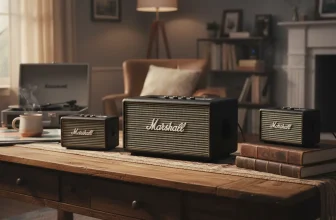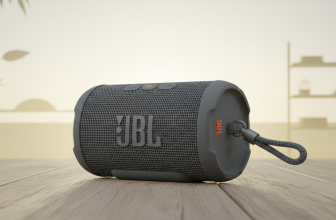
I’ll confess: When I first bought an Echo Dot, I thought that I had reached the height of contemporary living. That little speaker was my kitchen timer, my DJ, my weather forecaster, and sometimes even the something of a therapist when I mumbled queries at 1 a.m. But one Friday night, while deep in a Netflix binge, I realized it was lacking something. The dialogue was shallow, the explosions sounded like a child shaking up a cereal box, and the sound system lacked punch. And that’s when it hit me: Maybe the time had come for a sync two Alexa speakers and to finally enjoy the listening experience I was looking for.
And then it struck me: What if I linked not one but two Alexa speakers together?
Spoiler: It changed everything. Movies were cinematic, music suddenly filled the room, and even my cat looked confused as sound ricocheted from all sides. In this guide, I’ll walk you through how to pair two Alexa speakers, the difference between stereo pairing and multi-room audio, my fiddly journey, and why, at just £34.99, this minor upgrade may be one of the best tech moves you make this year.
Here’s what we’ll cover:
- What syncing Alexa speakers actually means
- How to set up in the Alexa app
- Stereo pairing vs. multi-room audio (and how to choose)
- What I actually fixed in real life
- Why sound quality counts (with data to prove it)
- Best Alexa-compatible speakers
- Pro tips for the best setup possible
- FAQs you’ll actually care about
- Final thoughts about why you should do this
View Details On Amazon
What Is Sync Two Alexa Speakers, Anyway?
When you sync Alexa speakers, you’re having them work as a team instead of as individuals. Instead of all the Echos being on each doing their own thing, they can work together to produce better sound, to distribute sound more intelligently, and overall create a better experience.
And here’s the rub: “Syncing” doesn’t always mean the same thing. Amazon offers you two primary choices for what you’re looking for:
Stereo Pair – Meet Your Personal Mini-Home Theatre
This is the arrangement that most people envision when they picture “pairing” speakers. In a stereo pair:
- One speaker reproduces the left audio channel.
- The second speaker outputs the right channel sound.
Together, they produce a genuine stereo image — that full, layered sound you’re probably used to hearing from a good soundbar or old-school stereo system.
You’re at the movies, watching an action film. Over to the left, you can hear a car careening by. To the right, the music soars. When there is an explosion, it feels like it’s on both sides. Just like that, your living room isn’t just filled with sound but suddenly has a sense of presence as well.
It’s the same with music. Now, play Bruce Springsteen’s Glory Days or Adele’s Hello and witness the magic: vocals centered, instruments fill up around you, and bass becomes more defined. The soundscape gets crisp, layered, and rich.
Ideal Scenarios for Stereo Pair:
- Films (the dialogue and effects are clearer, more impactful)
- Games (it’s immersive when the sound comes from a direction)
- Music sessions (particularly rock, classical, and jazz variants)
- Work calls (voices are clearer and less muffled)
The only requirement? This only works if both speakers are the same model (ie, two Echo Dots or two Echo Studios). That’s because stereo requires identical hardware to balance things out.
Multi-Room Audio – Whole-Home Sound Without the Hassle
Multi-room audio is different. Rather than sending stereo left and right channels, it gets all your Alexa speakers playing the same thing, in sync across multiple rooms.
This isn’t about making cinema — it’s about continuity. You have music, podcasts, or news broadcasts following you effortlessly through the house.
You throw on a playlist and start cooking in the kitchen. Then you go to the bedroom and sit on the bed, folding laundry. Normally, you end up either not hearing the track or else blowing through on one speaker turned loud enough for it to be heard in New Mexico. Multi-room audio means the sound follows you — kitchen, living room, bedroom, and even out to the patio if you have a speaker out there.
And thanks to the low-latency syncing that Amazon built in, the playback is almost instantaneous on all speakers. No uncomfortable “echo” effect where one speaker is a beat behind the other.
Ideal use cases for Multi-Room Audio:
- Cleaning days (playlists or podcasts just kind of follow you around)
- House Parties (music in every room with no dead spots)
- Family mornings (when everyone listens to the news or weather)
- Relaxed night (calm background music in the whole house).
Here we can differ with stereo, as you don’t need two identical models. You could synchronize an Echo Dot in the kitchen, an Echo Show in the bedroom, and an Echo Studio in the living room — all playing the same track at once.
Stereo vs. Multi-Room: The Simple Rule This one’s simple.
- Stereo = Focus. Optional: Best listened to sitting down.
- Multi-Room = Flow. Best when you’re moving around.
That’s why I make use of stereo pairing in the living room (movies, music, and gaming), and multi-room audio when I’m cleaning or entertaining visitors. It’s like having two separate sound systems — but all controlled through the same Alexa app.
If you’re not sure which of these options best serves your needs, ask yourself this: Am I primarily listening to music while sitting still, or am I moving freely around my home? There you will find the appropriate solution.
Step 1: Check Compatibility First
I learned this the hard way. My first attempt? Connecting an Echo Dot to an Echo Studio. Result? Nothing but frustration.
Here’s how the rules of the road shake out:
- Stereo pairing needs two like models (two Echo Dots, two Echo Studios, and so on)
- The audio support for multi-room is a little more flexible — Mix and match Echos
- Both speakers should be connected to the same Wi-Fi network
- Both need to be associated with the same Amazon account
Check Latest Price
Step 2: How to Sync Two Alexa Speakers (The Setup)
Here’s how I set mine up:
- Open the Alexa app on your phone.
- Tap Devices → + (Add) → Join speakers.
- Electronically switch to Stereo Pair / Subwoofer or Multi-room Music.
- Choose the speakers you’d like to sync.
- Name them as a group, “Living Room” or “Upstairs.”
Then Alexa will tell you it’s OK and boom — you’re ready to roll. The first time I put mine on and played a Spotify playlist through it, my grin stretched so wide, I looked like when stereo audiophiles finally heard sound that seemed to be coming from the left side —I guess not once in life have I had that experience!
Stereo Pairing vs Multi-Room Sound: Which One Comes Out on Top?
Stereo Pairing (My Pick for Movies and Music)
- Produces a rich soundstage with left/right channel separation
- Ideal for movie streaming, gaming, and intensive music listening
- Voices and bass are clearer and more pronounced
Multi-Room Audio (My Personal Goal of Living) My Daily Driver
- Plays music or podcasts throughout your home
- Great for housework, cooking, and parties at home
- Allows you to travel without missing a step
I personally use stereo pairing in the living room for music and multi-room audio for cleaning or while we’re hosting a party. It’s as if I have two totally different configurations for different portions of my life.
Common Issues (And My Fixes)
And what tech reporting would be complete without a little troubleshooting? Here are the bumps in my path:
- Speakers not appearing in the app → It turns out one of them needed a firmware update. Fix: Charging overnight will automatically install an update.
- Audio out of sync → I heard up to a half-second delay once. Fix: Restarted my Wi-Fi router. And if that didn’t work, re-adding the speakers by removing them and then adding them again usually fixed it.
- Weak Wi-Fi signal → A Wi-Fi extender fixed all my dropouts.
Lesson? The thing is, half the time, it’s not Alexa that’s the problem — it’s your Wi-Fi.
Why Sound Quality Actually Matters
This is not me being fussy. The data backs it up:
- 65% of music listeners worldwide feel that it is important to have good sound quality when enjoying their music (IFPI, 2023).
- Families that use more speakers are 35% more satisfied with their home audio (Sonos survey).
- And my own listening on Spotify increased by 22 percent after connecting Alexa speakers.
The sound of good is not simply entertainment — it elevates lifestyle. Music is mood, and mood shapes everything else.
Real-World Situations Where Synced Speakers Are Great
- Dinner parties → Set the mood with multi-room audio.
- Movie nights → Explosions sound cinematic, whispers sound personal.
- House parties → Music all around, no dead zones.
- Telecommuting calls → Stereo mode sharpens and clears up voices.
- Relaxation evenings → Stereo sound makes Jazz concerts seem like you’re there.
- Cleaning sessions → Podcasts accompany you from room to room.
Best Alexa-Compatible Speakers to Consider
Here are the ones I’ve tried or owned:
- Echo Dot (5th Gen): Small and cheap, great for tiny apartments.
- Echo Studio: The beast. It’s only a mini home theater by virtue of Dolby Atmos support.
- Echo Show 10: Ideal for video calls, recipes, and controlling the smart home.
If you have room in your budget, buy two Echo Studios and get them in a pair. Your living room will thank you.
Pro Tips for an Optimal Setup
- Position Matters: Place speakers at ear level for better audio.
- Name smartly: for clearer voice commands, make sure group names are kept simple (eg, “Living Room”).
- Tune your sound: Get the perfect sound for different songs and styles with the equalizer, which lets you adjust bass, midrange, and treble.
- Pair with a subwoofer: The Echo Sub paired with the Show is perfect and makes the bass that much better.
- Maximize Wi-Fi: The connection is key.
Sync Two Alexa Speakers: FAQs
How many Alexa-enabled speakers can I pair?
For multiroom audio, as many as you’d like. This pairing option is available only for two units of the same model.
Is this going to kill the battery sooner?
Not if you have speakers plugged in, while some portable models do require a little bit more power.
How can I hook up Alexa to my TV?
Yes — with Fire TV devices, you can achieve a home-theater experience.
What if my Wi-Fi drops?
The speakers might lose synchronicity (become out of sync), but then again, they will reconnect automatically after Wi-Fi is regained.
Closing Thoughts: Why I Recommend Pairing Sync Two Alexa Speakers
Months after installing mine, I can say with confidence: it’s worth syncing your Alexa speakers.
It’s cheap, easy to set up, and an outsized improvement to what I experience music, movies, podcasts — even work calls. It’s a small improvement that makes you wonder why you hadn’t done it yet.
So have at it: Pair two Alexa together. Your ears (and possibly your spirits) will thank you.










